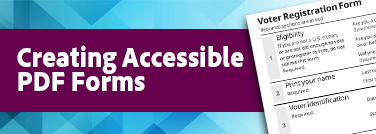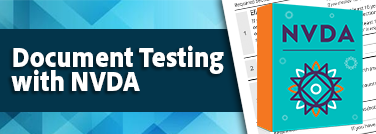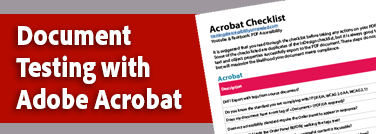Leveraging the power of Adobe InDesign for accessibility can cut down on hours of editing when you are trying to make a WCAG-compliant PDF. This class focuses on the basic best practices of Adobe InDesign and how to effectively use core accessibility features to produce more accessible documents.
Do you know what colors to use? What about WCAG 1.4.1 Use of Color or 1.4.11 Non-text Contrast. In this course you will learn the principles of accessible color combinations and how to use more than color alone to communicate complex information.
Accessibility for Microsoft Word can be a tricky thing. Many people think a native MS Word document is more accessible than a PDF. This session empowers you with knowledge and tools to create accessible Word documents from the start. If you are not the content author, we teach you what to look for and how to fix it to give you the best chance for an accessible PDF or a more accessible MS Word document.
If you struggle with irregular table errors when trying to pass your accessibility checker, this course is for you. Attendees will leave this session with a firm understanding of how to build compliant tables, table structure and what to watch out for when developing accessible tables.
This course is intended for individuals who are responsible for creating or evaluating PDF documents. By the end of this course, you will be able to identify common accessibility issues and know how to fix them. You will also be able to use a range of tools and techniques to ensure that PDF documents are fully accessible to all users, regardless of their ability.
One of the first steps in remediation is understanding what the tags should look like. Our hands-on approach to teaching this topic will give students critical thinking skills to evaluate compliance issues effectively and spot issues quickly.
There is nothing more nuanced than writing alternate Descriptions. How much detail to you give? What is meaningful? How do I know what to Artifact? We cover these questions and more while giving students a proven formula for evaluating images and figures.
Learn how to create more robust infographics. Topics include color contrast, meaningful alt-text and how to present complex infographics effectively. Learn best practices for maps. pie charts, flow charts, bar graphs and some tips for more robust organizational charts.
Start with the source or with a PDF, either way, forms will have you scratching your head. We clear away the confusion and give you step-by-step instructions for handling forms. Students get real-world form experience they can apply to their own workload and solve the mystery of forms once and for all.
As content creators, we have a responsibility to ensure our digital and print material are as accessible as possible to reach the widest audience. This class focuses on identifying the barriers and overcoming them with accessible design decisions that free your creativity rather than restrict it because the “content needs to be accessible.”
The ultimate way to ensure usability is to test your document for barriers with a screen reader. But using a screen reader can be daunting at first. This class focuses on the tools you need to know and the testing methods that will efficiently and definitively check your document for usability. Students leave the class with screen reader shortcuts and a checklist for evaluating a document.
Are you ready to tackle complex tables? Already understand scope and span but want to know how to solve the tough table problems? This course is for you. We walk you through cell IDs, fixing complex table structure. We introduce you to some tools that exponentially speed up your ability to handle complex tables. And we mean like 5 minutes versus 1 hour. Students leave this class with table remediation Superpowers!



